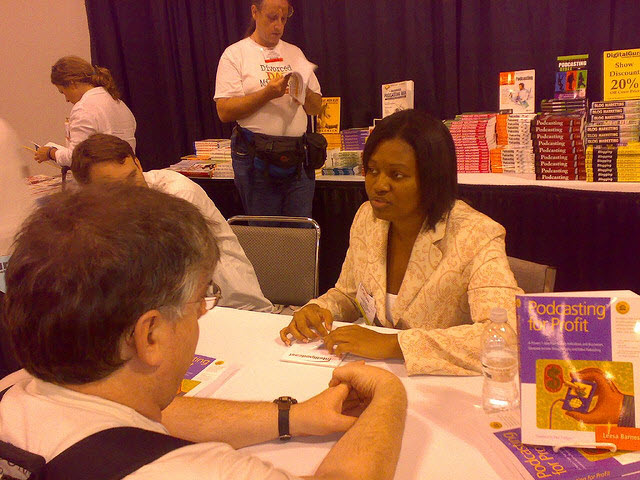Borrowed the title of this post from Rob, who borrowed it from Leo. The Mesh mini-podcasts are coming. Seven in total, all under 10-mins. Not sure when they’ll be posted, but I’ll link to them once I see them on the Mesh blog.
Unfortunately, I was using an omnidirectional mic which picked up everything. Silly me, I should’ve taken my condenser mic instead. Because of this, there was little I could do in post-production to remove the background chatter and music.
When I used Adobe Audition to remove the background noise, it did nothing. In Audacity, it was worst. It sounded as if the conversation took place underwater with a muffled beeping sound that I could only liken to talking on Captain Kirk’s bridge with a Klingon’s hands around my throat with the console going berserk in the background.
Aside from my terrible need to be a perfectionist, the interviews I captured were quite good. Either my interviewees were an intelligent group or I asked great questions (I think it’s the former).
I used an Uncle Seth song called To Be An Angel for the intro and outro. It was listed as #1 on the Podsafe Music Network as the most downloaded song in September 2006. Plus, Uncle Seth is a Canuck group and have been labelled as “the official band of Canaidan podcasting”, so it was a natural fit.
Which brings to mind something that I’ve seen people pick on when it comes to podcasting an event – that podcasts should be available immediately after the event and how dare anyone be made to wait.
If only these people knew.
Podcasting is a labour intensive task. Until someone creates a program that can edit out ums, ahs, clicks and hisses, you will always need a human being to do the editing and mixing. This is the only part of the podcasting process you cannot automate.
No one wants to put out shoddy work, at least I don’t. Hence, I always need to take the raw recordings and do something fancy schmancy with them. Once I have the raw recordings, this is what happens next:
- Select a podsafe song from the Podsafe Music Network.
- Create a script for the intro and outro.
- Get a voiceover artist to record the intro and outro.
- Take a 15-second portion of the podsafe song as the intro, then fade in and out the beginning and end. Repeat for the outro.
- Mix in the voice only intro with the music intro on a particular beat so it sounds as if it’s part of the song (you just can’t throw it in). Repeat for outro.
- Save as an MP3.
- Grab the raw recording and edit. For every 10-mins of recording that needs to be edited, set aside 30-minutes of time. Even the sounds,
- Save the edited recording as an MP3.
- Record a welcome message (this goes in between the intro and the edited recording). Save an an MP3.
- Take a washroom break because this has at least been 3-hours.
- Mix all 5, 6 or 7 tracks together.
- Before saving as an MP3 file, listen once through to make sure the levels are even and that the tracks are lined up nicely. If not, adjust, move, then listen again.
- Change the bit and sample rates so the file is saved in a smaller size.
- Edit the ID3 tag.
- Now save it in an MP3 format.
- Upload podcast to server.
- Grab the URL, login in to your blog, write something intelligent about the podcast episode you’re about to post (this is typically a title, show notes, show credits), and include the URL.
- Click on publish.
Podcast is live. Now, repeat the steps above for all the sessions that were recorded at your conference or event.
Does that answer your question as to why conference organizers don’t publish the recordings of their sessions as a podcast right away?
Technorati: mesh07, editing, mixing, audacity, mp3, uncle seth


Hey Leesa,
First of all, thanks for using the Uncle Seth tune in your podcast! Any chance we’ll see you at the show on Saturday? (C’est What, Front & Church, tonnes of fun!)
Also, as far as noise reduction in Audition & Audacity — well, I’m not as much of an Audacity user but it does have many of the same features as Audition, which I’m a HUGE fan of, and I have to say that the noise reduction capabilities of Audition are actually really stellar. If you’d like, I’d be happy to go through those features with you at some point and see if we can get your stuff sounding cleaner. Hey, that Radio & Television degree must be good for something, right?
Seeya soon,
– J.
Hey Leesa – sorry I missed you at the Mesh get-together! I would have liked to have met you in person!